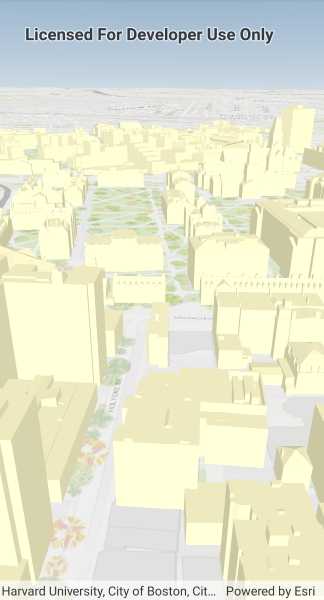Use augmented reality (AR) to quickly explore a scene more naturally than you could with a touch or mouse interface.

Use case
You can use AR to drop into an area and visualize information, like a proposed development or a historical model of a city. You could use flyover AR to explore a city by walking through it virtually.
How to use the sample
When you open the sample, you'll be viewing the scene from above. You can walk around, using your device as a window into the scene. Try moving vertically to get closer to the ground. Touch gestures which
How it works
- Create the
ARSceneViewand add it to the view. - Create the scene, add content, then display it.
- When the content you want to view loads, get its center point and use that to create the origin camera for the AR view. Note that the altitude should be set so that all scene content is visible. For a city, a good value might be a bit higher than the tallest building. The sample uses 600 meters in the absence of tall buildings in the sample data.
- Set the translation factor so that you can move through the scene easily. With a translation factor of 800, you will move 800 feet in the scene for every foot you move the physical device.
- Set the space effect to
Starsand atmosphere effect toRealisticto create an immersive experience.
Relevant API
- ARSceneView
About the data
This sample uses a sample integrated mesh layer provided by Vricon. The integrated mesh layer shows an area around the US-Mexico border.
The world elevation service is used to show terrain while the integrated mesh layer loads.
Additional information
This sample requires a device that is compatible with ARKit.
Flyover AR is one of three main patterns for working with geographic information in augmented reality. See the Display scenes in augmented reality for more information.
This sample uses the ArcGIS Runtime Toolkit. See Display scenes in augmented reality in the guide to learn about the toolkit and how to add it to your app.
Tags
augmented reality, bird's eye, birds-eye-view, fly over, flyover, mixed reality, translation factor
Sample Code
// Copyright 2019 Esri.
//
// Licensed under the Apache License, Version 2.0 (the "License"); you may not use this file except in compliance with the License.
// You may obtain a copy of the License at: http://www.apache.org/licenses/LICENSE-2.0
//
// Unless required by applicable law or agreed to in writing, software distributed under the License is distributed on an
// "AS IS" BASIS, WITHOUT WARRANTIES OR CONDITIONS OF ANY KIND, either express or implied. See the License for the specific
// language governing permissions and limitations under the License.
using Android.App;
using Android.OS;
using Android.Widget;
using AndroidX.AppCompat.App;
using Esri.ArcGISRuntime.ARToolkit;
using Esri.ArcGISRuntime.Mapping;
using Esri.ArcGISRuntime.UI;
using System;
namespace ArcGISRuntimeXamarin.Samples.ExploreScenesInFlyoverAR
{
[Activity(ConfigurationChanges =
Android.Content.PM.ConfigChanges.Orientation | Android.Content.PM.ConfigChanges.ScreenSize)]
[ArcGISRuntime.Samples.Shared.Attributes.Sample(
name: "Explore scenes in flyover AR",
category: "Augmented reality",
description: "Use augmented reality (AR) to quickly explore a scene more naturally than you could with a touch or mouse interface.",
instructions: "When you open the sample, you'll be viewing the scene from above. You can walk around, using your device as a window into the scene. Try moving vertically to get closer to the ground. Touch gestures which ",
tags: new[] { "augmented reality", "bird's eye", "birds-eye-view", "fly over", "flyover", "mixed reality", "translation factor" })]
public class ExploreScenesInFlyoverAR : AppCompatActivity
{
// Hold references to the UI controls.
private ARSceneView _arSceneView;
protected override void OnCreate(Bundle bundle)
{
base.OnCreate(bundle);
Title = "Explore scenes in flyover AR";
CreateLayout();
}
private void CreateLayout()
{
// Create the layout.
LinearLayout layout = new LinearLayout(this) { Orientation = Orientation.Vertical };
// Add the AR scene view.
_arSceneView = new ARSceneView(this);
layout.AddView(_arSceneView);
SetContentView(layout);
// Request camera permission. Initialize will be called when permissions are granted.
Initialize();
}
private async void Initialize()
{
// Create the scene.
Scene flyoverScene = new Scene(new Uri("https://www.arcgis.com/home/item.html?id=76ffb1a9e26b4602a04c209146bf2cd3"));
try
{
// Display the scene.
await flyoverScene.LoadAsync();
_arSceneView.Scene = flyoverScene;
// Start with the camera at the scenes initial viewpoint.
Camera originCamera = new Camera(flyoverScene.InitialViewpoint.Camera.Location.Y, flyoverScene.InitialViewpoint.Camera.Location.X, 200, 0, 90, 0);
_arSceneView.OriginCamera = originCamera;
// set the translation factor to enable rapid movement through the scene.
_arSceneView.TranslationFactor = 1000;
// Enable atmosphere and space effects for a more immersive experience.
_arSceneView.SpaceEffect = SpaceEffect.Stars;
_arSceneView.AtmosphereEffect = AtmosphereEffect.Realistic;
}
catch (Exception ex)
{
new Android.App.AlertDialog.Builder(this).SetMessage(ex.Message).SetTitle("Error").Show();
System.Diagnostics.Debug.WriteLine(ex);
}
}
protected override async void OnPause()
{
base.OnPause();
await _arSceneView.StopTrackingAsync();
}
protected override async void OnResume()
{
base.OnResume();
// Start AR tracking without location updates.
await _arSceneView.StartTrackingAsync();
}
}
}